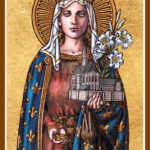
St. Clare of Assisi
St. Clare of Assisi
Saint Clare of Assisi: The Radiant Light of Poverty and Devotion
When they lived:
Saint Clare of Assisi, born Chiara Offreduccio, lived during the late 12th and early 13th centuries. She was born on July 16, 1194, in Assisi, Italy, and she passed away on August 11, 1253, at the age of 59.
Where they lived:
Saint Clare spent the majority of her life in the town of Assisi, nestled in the picturesque Umbrian region of Italy. This enchanting town became the backdrop for her remarkable journey of faith and selflessness.
Notable world events during the time of her life:
- The Third Crusade (1189-1192): As a young girl, Saint Clare witnessed the fervor and upheaval caused by the Third Crusade, a major military campaign led by European leaders to recapture the Holy Land from Saladin’s forces. This event undoubtedly had a profound impact on the religious atmosphere of her time.
- Magna Carta is signed (June 15, 1215): In 1215, while Clare was beginning her religious life, the Magna Carta was signed in England. This historic document laid the groundwork for modern constitutional law and established principles that would shape the rights and liberties of people worldwide.
- The Mongol Empire Expands (1206-1227): During Saint Clare’s lifetime, the Mongol Empire under Genghis Khan and later under his successors, continued its remarkable expansion, impacting trade, culture, and communication across vast territories and civilizations.
- The University of Oxford is Founded (c. 1096-1167): Although this event happened before Saint Clare’s birth, it highlights the growing intellectual and educational landscape during her time. The establishment of prestigious universities like Oxford paved the way for knowledge dissemination, ultimately influencing the intellectual climate of Europe.
Her patronage:
- Television and Visual Communication: Interestingly, Saint Clare is the patron saint of television and visual communication. This unusual association is believed to stem from an incident where, despite being bedridden, she was said to have witnessed the celebration of Mass on the wall of her room, as though watching it on a screen.
- Eye Disorders: Saint Clare’s intercession is sought for those suffering from eye ailments and vision problems, symbolizing the clarity of her unwavering faith and her ability to bring light to those in spiritual darkness.
- Goldsmiths and Embroiderers: These patronages are attributed to her skillful craftsmanship and dedication to her chosen vocation as a nun, emphasizing her commitment to the art of embroidery and adornment used in religious contexts.
- Laundry Workers: Saint Clare’s compassion and humility extend even to the humble laundry workers, reflecting her life of simplicity and service.
- Good Weather: In some regions, Saint Clare is invoked to protect crops from adverse weather conditions, demonstrating the belief in her spiritual connection to nature and its elements.

Saint Clare of Assisi’s life continues to inspire countless individuals around the world, her unwavering faith and commitment to a life of poverty and devotion shine as a beacon of hope in an ever-changing world. Her story serves as a reminder that true wealth lies not in material possessions but in a heart dedicated to love and service.
Following the Footsteps of Francesco
She was the beautiful eldest daughter of Favorino Sciffi, Count of Sasso-Rosso and his wife Ortolana As such, Clare’s family was wealthy and influential. She was taught to read and write, as well as needlework and spinning yarn. Though coming from a rich family and living in a palace, Clare had little interest in her luxurious surroundings.
The Poor Ladies of San Damiano
On March 20, 1212, Clare professed her vows, dedicating her life to God. That day marked the birth of the Second Order of St. Francis. Soon after, Agnes, Clare’s sister, joined her. They moved to San Damiano Church, recently built by Francis. Not long after, other women joined them, including residents of San Damiano. Known for their life of asceticism, they became known as the “Poor Ladies”.
Clare’s group was known as the Order of San Damiano. In 1216, Clare became the abbess of the order. She spent her days praying and doing manual work. At the same time, she was also dedicating her time to changing the governing rule of the order from Benedictine spirituality to the newly founded Franciscan rule. Their daily lives consisted of prayer and manual labor. Despite the radical life of poverty they had, the sisters were very happy because the Lord was close to them all the time.
Toward the end of Francis’ life, Clare cared for him and accompanied him when he breathed his last in 1226. Despite ill health, Clare resumed to promote and guide the growth of their order. After years of labor for the Order, Clare went to her heavenly reward in 1253. Her remains were placed in the Chapel of San Giorgio while the church dedicated to her remains was being built. At Pope Innocent’s request, the canonization process for Clare began immediately. In August 1255, two years after Clare’s death, Pope Alexander IV canonized her. Following Clare’s canonization, her sisters became known as the Order of St. Clare, or “Poor Clares”.
Five Interesting Facts About St. Clare of Assisi
- St. Clare of Assisi is the patron saint of television. This was because late in her life, she fell so sick that she was not able to
attend Mass. Miraculously, the images and sounds of the entire mass appeared in full on the wall of her room, like how televisions work. today. She is also the patroness of eye disease, goldsmiths, and
laundry. - St. Clare and her sisters in the Order wore no shoes, ate no meat,
lived in a poor house and kept silent most of the time. - In 1224, an army of rough soldiers under Frederick II, known as the
Saracens came to attack Assisi. Although very sick, St. Clare went out.
and had the Blessed Sacrament placed on the wall where the enemies could
see it. Then, on her knees, she begged God to save the sisters, and a
A sudden fright struck the attackers, and they fled as fast as they could.
without harming anyone in Assisi. - Two days before St. Clare of Assisi died, Pope Innocent IV approved
that the rule she wrote would serve as the governing rule for the order.
of San Damiano. - When St. Clare’s tomb was opened, it was discovered that her body,
though blackened with age, was still incorrupt.
Prayer to St. Clare of Assisi
O God, who in your mercy led Saint Clare to a love of poverty, grant, through her intercession, that, following Christ in poverty of spirit, we may merit to contemplate you one day in the heavenly Kingdom. Through our Lord Jesus Christ, your Son, who lives and reigns with you in the unity of the Holy Spirit, one God, for ever and ever Amen.



